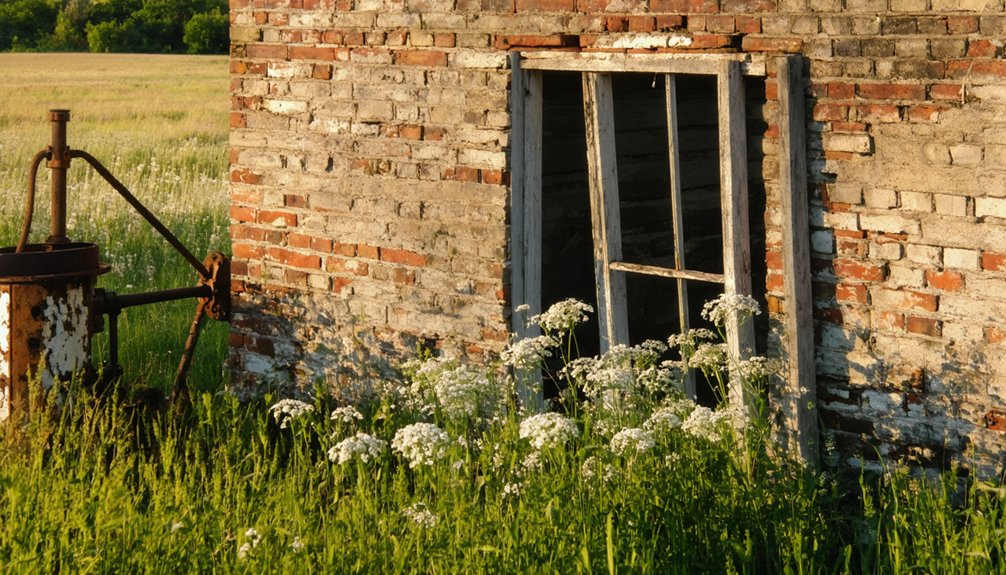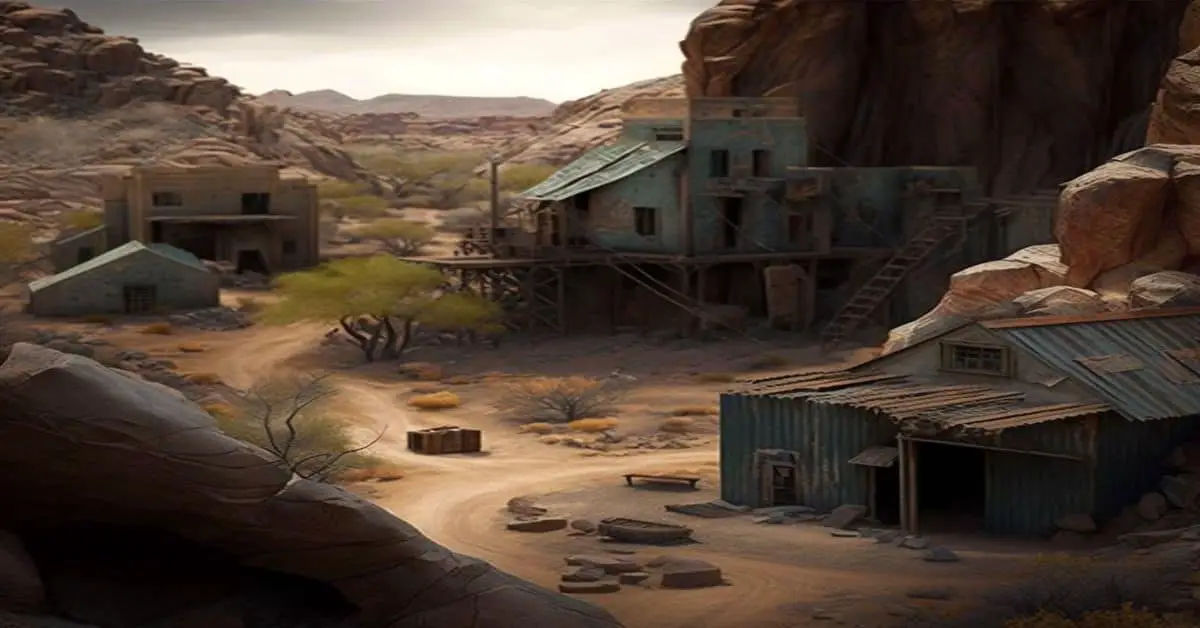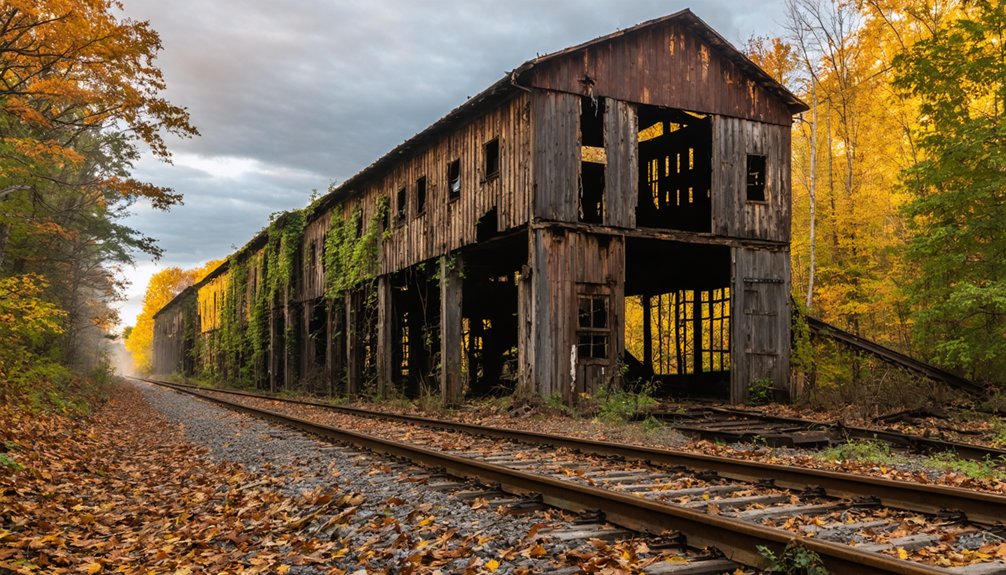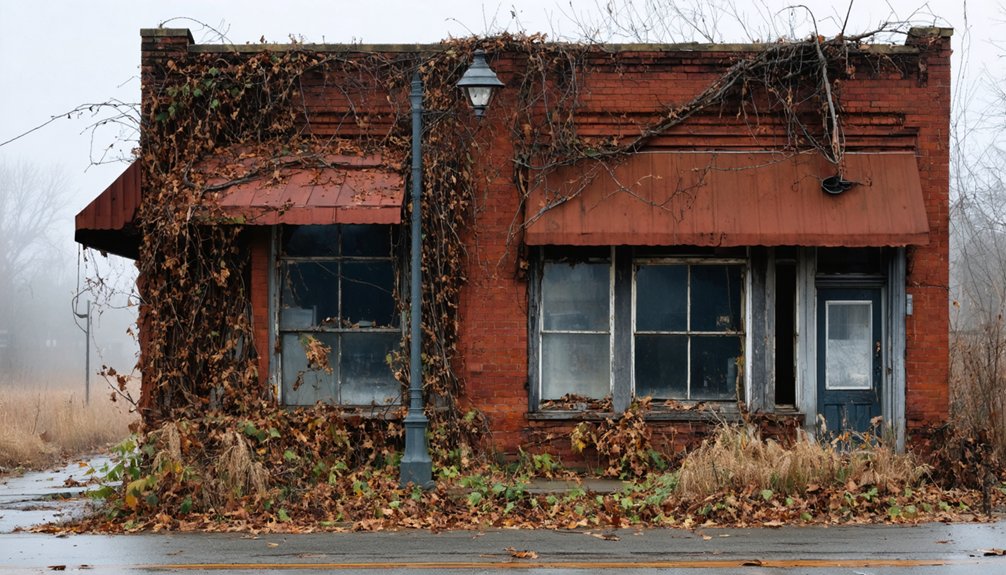You’ll find Elizabethtown’s remnants along the Mississinewa River in Delaware County, Indiana, where Joseph Wilson’s flour and sawmills first attracted settlers in the 1830s. The town, platted in 1845 and named for Wilson’s daughter Elizabeth, thrived as a riverside trading hub with mills, distilleries, and merchants. Today, only farmland and the historic Elizabethtown Cemetery mark where this frontier community once stood. The town’s rich history reveals fascinating insights into early Indiana settlement patterns.
Key Takeaways
- Elizabethtown was established in 1845 along the Mississinewa River in Delaware County, Indiana, named after Joseph Wilson’s daughter Elizabeth.
- The town flourished initially due to its flour mills, sawmills, and riverside trade but failed to secure the county seat position.
- Economic activity centered around the Mississinewa River, with facilities including mills, a distillery, general store, and Presbyterian church.
- A devastating fire around 1870 destroyed Uriah Powers’ distillery and store, contributing to the town’s eventual decline.
- Today, only farmland and the historic Elizabethtown Cemetery remain as physical evidence of this once-thriving frontier community.
The Birth and Early Years of a Riverside Settlement
While pioneers were steadily pushing westward across Indiana in the early 1800s, a small settlement emerged along the north bank of the Mississinewa River that would become Elizabethtown.
You’ll find its pioneer heritage deeply rooted in the 1830s, when Joseph Wilson established flour and sawmills that attracted early settlers to this promising location.
The town’s family legacy was cemented in 1845 when Wilson officially platted the settlement, naming it after his daughter Elizabeth. The town had aspirations of becoming the county seat position, though this dream would never materialize.
Some sources suggest it honored Elizabeth Branham, wife of another founder. Like many places named Elizabethtown, this settlement required disambiguation efforts to distinguish it from other similarly named locations.
What’s certain is that by 1844, you’d have found a proper post office serving the growing community of farmers, millers, and merchants who’d carved out their piece of the American frontier along the river’s fertile banks.
Economic Life Along the Mississinewa
Before railroads transformed the region’s commerce, the Mississinewa River served as an essential economic artery for early settlers around Elizabethtown.
You’d have found local farmers bringing their grain and pork to riverside mills, distilleries, and curing houses. River trade flourished as merchants loaded these processed goods onto flatboats and pirogues, shipping them downstream to larger markets in Marion and Peru.
With an average of 3.3 feet per mile, the Mississinewa’s swift current made it ideal for transporting goods downstream. The agricultural processing hubs along the Mississinewa supported the valley’s growth, with ambitious plans for expansion through the Indiana Central Canal project of 1836.
Though the canal never materialized after the Panic of 1837, the river’s economic importance continued until the 1880s. The discovery of natural gas then shifted the region’s focus from river-dependent commerce to industrial development, fundamentally changing Elizabethtown’s economic landscape. The area’s transformation was further accelerated when the U.S. Army Corps constructed flood control dams in the 1960s.
Town Layout and Notable Structures
Situated just north of a distinctive bend in the Mississinewa River, Elizabethtown occupied a strategic position in Section 12 of Washington Township, Delaware County.
A general store and distillery operated within the town’s boundaries, contributing to its commercial vitality during the 1830s.
Joseph Wilson’s town design centered around the convergence of County Roads 370 West and 1270 North, creating a compact settlement that showcased structural significance through its carefully planned layout.
The town’s key structures included:
- Elizabeth Mill, a flour grist mill that served as the community’s economic anchor
- A Presbyterian church and schoolhouse that formed the social and educational core
- Multiple specialized shops, including a blacksmith, carpenter, and cabinet maker
- A riverside dock system with a covered bridge that facilitated trade and transport
These structures reflected the ambitious vision of a thriving river port community, though the town would later fade into Delaware County’s pastoral landscape. The devastating Great Flood of 1913 ultimately led to the closure of the grist mill, marking a final turning point in Elizabethtown’s decline.
Rise and Decline of a Frontier Community
After Joseph Wilson platted Elizabethtown in 1845, the frontier settlement experienced a promising but brief period of growth centered around its strategic location and vital grist mill operations.
The town’s settlement patterns evolved from initial pioneers like William Dilts in the 1820s to established farming families who fostered strong community cohesion through churches and social institutions. Uriah Powers operated the town’s first distillery and store until a devastating fire around 1870.
You’ll find that Elizabethtown’s decline began when it missed significant developments that benefited other Delaware County towns.
While neighboring communities prospered from railroad connections and the regional gas boom of the late 1800s, Elizabethtown’s isolation proved fatal.
The lack of transportation infrastructure and diminishing economic opportunities gradually transformed this once-hopeful frontier hub into a ghost town, with only a handful of residents remaining to mark its former existence.
What Remains: Legacy in Local History
While modern visitors to Elizabethtown’s former location will find only farmland today, the town’s legacy persists through its cemetery and rich historical documentation.
The cultural significance of this ghost town lives on through local archives and community remembrance, offering a window into 19th-century pioneer life.
You’ll find Elizabethtown’s enduring impact preserved in several ways:
- The historic Elizabethtown Cemetery remains as the sole physical remnant, now a haunting reminder of the vanished community.
- Detailed records in the Delaware County Genealogist and Historian publications maintain the town’s story.
- Family histories and tax records from 1847 provide insights into the settlement’s social fabric.
- Local historical societies use Elizabethtown’s story to educate about frontier communities and economic shifts.
Frequently Asked Questions
Were There Any Documented Conflicts Between Elizabethtown Settlers and Native Americans?
You’ll find no specific records of settler interactions in Elizabethtown itself, though native conflicts occurred throughout Delaware County during the early 1800s, including trading post burnings and territorial disputes.
What Happened to Elizabeth Wilson After the Town Was Named?
Like a fading footprint in history’s sand, Elizabeth Wilson’s fate after the town’s naming remains unknown. You won’t find records of her later life, though her legacy lives through the town’s memory.
Did Any Famous People Ever Visit or Live in Elizabethtown?
You won’t find any records of famous visitors or notable residents in historical documents. Only Joseph Wilson and Uriah Powers, local figures who helped establish the town, are documented.
What Was the Highest Recorded Population of Elizabethtown During Its Peak?
Like wisps of smoke from a forgotten fire, you won’t find exact population numbers for this settlement. Historical records don’t reveal peak years or population trends during its brief existence.
Were There Any Significant Natural Disasters That Affected Elizabethtown’s Development?
You won’t find any documented flood impacts or fire disasters affecting the town’s development. Historical records show economic and infrastructure challenges, not natural calamities, caused its eventual decline.
References
- https://www.thestarpress.com/story/news/local/2021/07/21/bygone-muncie-ghost-towns-lurk-around-delaware-county-indiana/8018338002/
- https://www.onlyinyourstate.com/experiences/indiana/ghost-town-cemetery-indiana
- https://www.thestarpress.com/story/news/2024/08/13/history-recalls-ghost-towns-of-delaware-county/74771334007/
- https://www.findagrave.com/cemetery/84918/elizabethtown-cemetery
- https://www.hmdb.org/m.asp?m=141424
- https://en.wikipedia.org/wiki/Elizabethtown
- https://kids.kiddle.co/Elizabethtown
- https://yorktownhistory.online/wp-content/uploads/2020/02/A-twentieth-century-history-of-Delaware-County-Indiana-Vol-1-1908.pdf
- http://www.robbhaasfamily.com/Places/Towns-Delaware Co
- https://yorktownhistory.online/wp-content/uploads/2020/02/A-twentieth-century-history-of-Delaware-County-Indiana-Vol-2-1908.pdf



